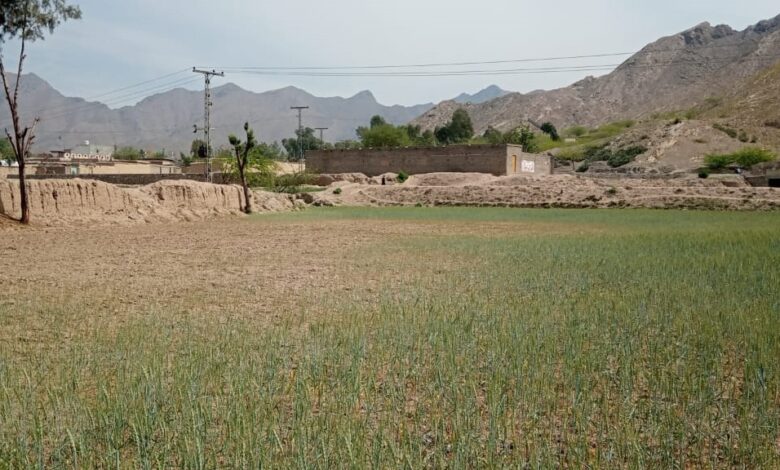
Syed Bacha Mohmand
Sawdagar Khan, a farmer from Tehsil Halimzai Sultankhel in Mohmand district, experienced the devastating impacts of climate change when his entire onion crop worth Rs. 180,000 was destroyed in the 2010 floods.
In an interview with TNN, Sawdagar Khan expressed how this was the first time he faced such economic problems, as the flood washed away the onions, leaving 12 members of his family unemployed. Since then, the combination of rising temperatures and decreased rainfall each year has caused their agricultural activities to shrink, eventually leading to the complete end of cultivation by the end of 2016.
To support his family, Sawdagar Khan now volunteers his services in Ghalanai, the headquarters of Mohmand district. He assists people in obtaining identity cards, passports, and other documents, receiving small amounts of money in return for their livelihood.
Also Read: Khyber: Mother and Newborn Son Die Due to Inexperienced Fake Doctor
This plight is not exclusive to Sawdagar Khan alone but is shared by hundreds of farmers in Halimzai Tehsil, who have also lost their livelihoods due to climate change and drought.
According to Asif Iqbal, the District Director of the Mohmand Agriculture Department, it has been evident for the past decade that the Mohmand district is among the regions most severely affected by climate change.
Fifteen years ago, Halimzai Tehsil boasted excellent farming practices, with numerous ornamental plants and fruit orchards established by the Agriculture Department. These gardens provided abundant yields, and the cultivation of superior vegetable varieties brought significant income to the farmers.
The local population was largely self-sufficient in crops like wheat, millet, and others grown on irrigated and rainfed lands. However, over the past decade, the adverse effects of climate change have caused a rapid decline in the water table, rendering agricultural lands barren and severely impacting landowners.
Misal Khan, another farmer from Halimzai Tehsil, used to grow various vegetables on his land and sell them in local markets. However, due to the changing conditions, he now sells vegetables from a shop, having to travel to vegetable markets in Peshawar and Charsadda.
Misal Khan recalled the time when their vegetable farming was prosperous, often purchasing vegetables from other local farmers and supplying them to markets in Peshawar and Punjab. However, the situation has changed, and now it is a challenge to make ends meet.
Malik Gulab Sher Mohmand, the president of Anjuman Zamindaran Mohmand, believes that the concept of farming has been undermined by the declining water table in the Gandao area of Halimzai Tehsil. Citing a survey, he highlighted that 64% of rainwater rapidly drains through storm drains during flash floods, contributing to soil erosion and crop damage instead of replenishing groundwater levels. He suggested the construction of small dams, check dams, and pond dams in affected areas to improve the situation.
Dr. Jan Muhammad, a Ph.D. holder in Agriculture Water Management from Peshawar University, emphasized that the economy of Mohmand district heavily relied on agriculture, which has been severely impacted by climate change.
He referred to a survey conducted by the World Bank in 2010, indicating a consistent annual decline of 3 to 4 feet in the groundwater level of Halimzai Tehsil. Previously, when rainfall in Mohmand was normal and extended into winter, the underground water storage would increase. However, the concrete population growth, paved streets, and buildings have significantly reduced the amount of rainwater absorption by the soil surface.
Dr. Jan Muhammad further explained that the introduction of tube wells and later solar panels in Halimzai Tehsil has contributed to the depletion of underground water storage. He emphasized the need for controlled digging of tube wells and the implementation of an irrigation policy to mitigate these negative effects of climate change.
Currently, many farmers in the Mohmand district continue to use traditional irrigation methods, where approximately 50% of water reaches the crops while the remaining 50% is wasted. Drastic changes are required to adapt to the current situation, such as the installation of high-efficiency irrigation systems and the adoption of drip irrigation for vegetable cultivation. Moreover, embracing modern technologies and practices can help maximize crop production while minimizing water usage.
The economic backbone of Mohmand district, once reliant on thriving agriculture, now faces immense challenges due to the far-reaching impacts of climate change. It is crucial for both the government and the local community to come together and address these issues urgently.
Implementing sustainable farming practices, raising awareness about climate change, and promoting water conservation measures are essential steps toward safeguarding the livelihoods of farmers in the Mohmand district.
By taking concerted action, there is hope for a resilient agricultural sector that can withstand the changing climate and ensure a better future for the farming community in the region.